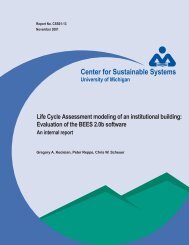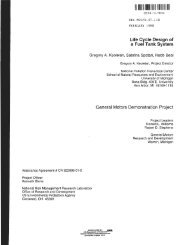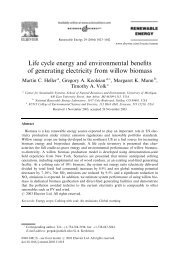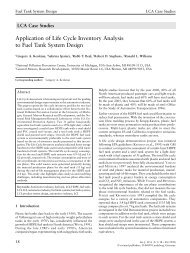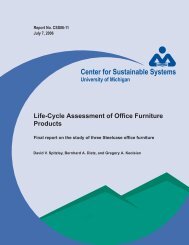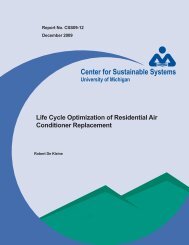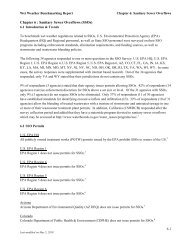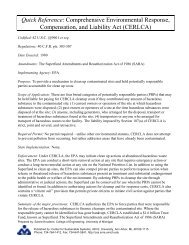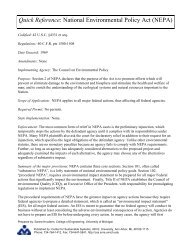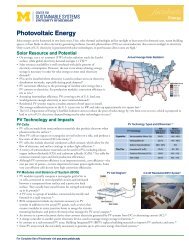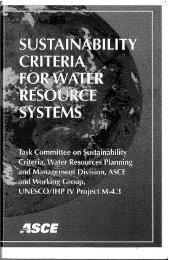A Life Cycle Assessment of the PureCell Stationary Fuel Cell System ...
A Life Cycle Assessment of the PureCell Stationary Fuel Cell System ...
A Life Cycle Assessment of the PureCell Stationary Fuel Cell System ...
- No tags were found...
You also want an ePaper? Increase the reach of your titles
YUMPU automatically turns print PDFs into web optimized ePapers that Google loves.
• The TMS is manufactured 250 miles from UTC Power, transporting 2250 lb,<br />
which is equal to 281 tmi.<br />
Water Treatment <strong>System</strong> (WTS)<br />
The WTS provides high purity water to <strong>the</strong> cell stack assembly (CSA) cooling loop. It<br />
also collects condensate from <strong>the</strong> condenser, strips CO<br />
2<br />
from <strong>the</strong> entering condensate,<br />
removes organic particles and minerals and filters out particulates.<br />
Materials/Assemblies Amount Unit<br />
Steel cold rolled coil IISI 200 lb<br />
Glass fiber I <strong>Pure<strong>Cell</strong></strong> system 135 lb<br />
Total 335 lb<br />
Processes Amount Unit<br />
Cold transforming steel <strong>Pure<strong>Cell</strong></strong> system 200 lb<br />
Electric welding steel 3 <strong>Pure<strong>Cell</strong></strong> system 5 m<br />
Table 4-20: Water Treatment <strong>System</strong> (WTS) inventory data<br />
• Glass fiber is used as insulation material.<br />
• Transport unknown.<br />
Scrap Rates<br />
Most <strong>of</strong> <strong>the</strong> materials that appear in <strong>the</strong> inventory tables are not raw materials, but<br />
materials that already went through a manufacturing process (e.g., steel and aluminum).<br />
These material manufacturing processes, including, for example, emissions and energy<br />
input, are generally included in <strong>the</strong> way <strong>the</strong>se materials are modeled in SimaPro.<br />
However, <strong>the</strong> weights that appear in <strong>the</strong> inventory tables described in this chapter are<br />
based on a weight breakdown <strong>of</strong> <strong>the</strong> <strong>Pure<strong>Cell</strong></strong> system. Thus, so far only <strong>the</strong> materials<br />
that actually end up in <strong>the</strong> final product have been taken into account. But in <strong>the</strong><br />
manufacturing processes <strong>of</strong> <strong>the</strong> <strong>Pure<strong>Cell</strong></strong> subsystems and components a certain amount<br />
<strong>of</strong> scrap is produced which does not end up in <strong>the</strong> final product. Scrap rates for <strong>the</strong><br />
majority <strong>of</strong> <strong>the</strong> materials were not included in <strong>the</strong> <strong>Pure<strong>Cell</strong></strong> system LCA model at all.<br />
Many <strong>of</strong> <strong>the</strong> <strong>Pure<strong>Cell</strong></strong> subsystem and component manufacturing processes are very<br />
specific, and due to <strong>the</strong> fact that <strong>the</strong> <strong>Pure<strong>Cell</strong></strong> subsystems and components come from<br />
external suppliers <strong>the</strong>se data are simply not available. The scrap rates that are included in<br />
this LCA are for steel and copper. The criterion to include <strong>the</strong> steel scrap rate is its high<br />
weight percentage relative to <strong>the</strong> total <strong>Pure<strong>Cell</strong></strong> system; <strong>the</strong> copper scrap rate is<br />
included because it has a significant weight contribution and a relatively high<br />
environmental impact.<br />
37



